Desire, disease and death are inseparable in Puccini’s La bohème. As Rodolfo says to Marcello in Act 3, when he explains why he is leaving Mimì, despite his love for her: “Mimì è tanto malata! Ogni di più declina. La povera piccina è condannata!”
Director Floris Visser makes this integration of melody, malady and la mort vividly and visually undeniable in this Glyndebourne production, which premiered during this summer’s festival and is now, in a revival directed by Simon Iorio, being toured around the UK. The shadow of death – the tall, menacing Peter Van Hulle – haunts and stalks the stage throughout, an impassive, patient Grim Reaper who knows that his time will come: a projection of Mimì’s perhaps subconscious recognition of her fate.
The contrast between her fearful response to the lurking figure in black and the oblivious disregard of the revellers at Café Momus when ‘Parpignol’ releases a bundle of blood-red balloons that float up to the heavens – an intimation of their own fate? – is striking. Moments before, the diners have opened their menus to reveal a ghastly insignia: a black skull – a threatening reminder of human mortality. Do Rodolfo’s words to Marcello express not only his fears for Mimì but also his fears for himself? Disease is an essential part of her life and her love. It is her ‘beauté maladive’ that attracts Rodolfo; death and her sexuality are one and the same.
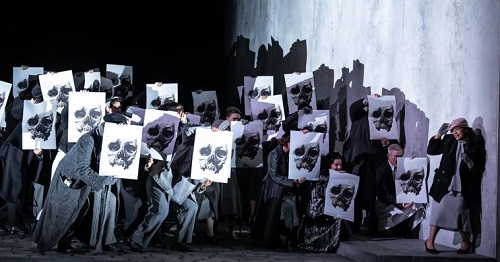
Dieuweke Van Reij’s single-set design is obviously pragmatic for touring. But, much more that, it’s a striking visual representation of the abyss to which poverty and deprivation lead. And, that this fate is both oppressive and inescapable is pushed home by the high, plain walls which border the central cobbled street which leads, seemingly over a bridge, to a dark emptiness. It’s both the particular misery of the garret and the more universal paucity of the Parisian poor. If Alex Brok’s lighting at times illuminates the pathway with warmth, then there are also countering, looming shadows: illusion and reality.
So, in Act 1 a pebble-stone street stretches upwards into darkness. Café Momus’s chairs are stacked high against one wall, with Rodolfo perched aloft. A manhole cover is lifted to provide, when fed with Rodolfo’s play, a warmth that is as transient as his drama. There’s no alleviation of the gloom when we arrive at the Café: even the soldiers’ uniforms are grey, and their march has a sombre tread. There are occasional splashes of colour to alleviate the prevailing monochrome, but they are ominous: the red of Parpignol’s balloons which looks back to the abstract violence of Marcello’s ‘Red Sea’ canvas; the soft pink of Mimì’s beret which anticipates the sickly flowers that foreshadow her demise in Act 3. The ‘gigli e rose’ (lilies and roses) that she describes arranging in Act 1 take on a consumptive hue of suffering here, and Act 3’s Barrière d’Enfer tollgate is less a pathway from the city to a more wholesome rural environment than an entrance to an insalubrious urban quarter where sex workers, border police and smugglers congregate and co-mingle.
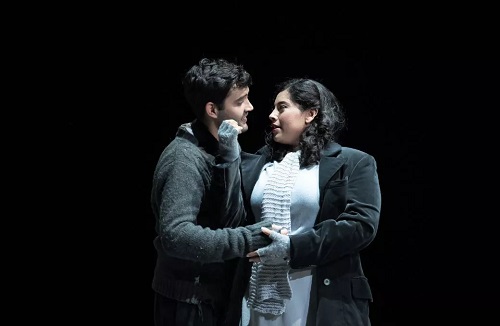
Visser discretely nudges the action forward to the 1940s, and the existential bleakness of the visuals is powerful. But, Puccini’s music offers a counterforce. At the Marlowe Theatre in Canterbury, the Nicaraguan-American soprano Gabriella Reyes shone and glowed, even as Mimì ‘faded’. Her lyricism was opulent and strong, but also supremely flexible, and she held back and then unleashed the most fervent reaches with judicious insight. One might find her Act 3 appeals a bit too hearty – there seemed to be a sudden collapse in Act 4, rather than the steady decline that Rodolfo observes – but perhaps a bit less sentimental wilting is welcome, and who would not want to enjoy Reyes’s paradoxically plush vibrancy.
As Rodolfo, the Uzbekistan tenor Bekhzod Davronov impressed from his very first utterance – perched perilously atop the stacked Momus chairs. His tenor is sweet, relaxed, and has a lovely Italianate ping. It soars effortlessly. He acted here with consummate awareness and presence. The first Act 1 exchanges of Rodolfo and Mimì seemed a bit breathless and hasty, but conductor Rory Macdonald widened the vista for the principals’ solos, and both Davronov and Reyes had the control to ride the broad arcs. They offered much elegant vocal artistry.
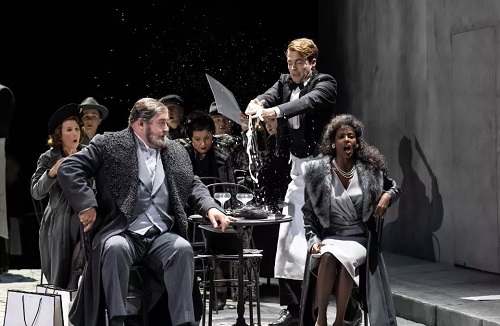
Mariam Battistelli’s Musetta was rather too calculating for my taste. The Ethiopian-born Italian soprano seemed to arrive at Café Momus with a cruel plan hatched rather than to respond spontaneously to flirtatious opportunism. Though Battistelli’s singing was precise and pointed, this Musetta seemed too cold for the ‘emotional melt’ of the final Act to feel credible – even her grey (of course) frock seemed chiselled rather than flowing; and one was reminded of Marcello’s comments in Act 1 that his hands are as cold as if he had been touching Musetta’s heart.
The camaraderie of the bohemians was as lively as is customary. Luthando Qave was an impassioned Marcello, William Thomas an eloquent Colline, and, in top hat and tails, his battered violin case stuff with delectables, Luvuyo Mbundu was a strutting show-off as Schaunard. There were some surprising details, though. Benoît was a drunken landlord whose staggering entrance sent his bottle of wine smashing against the wall; and, doubling up as Alcindoro, Darren Jeffrey also conveyed the old man’s pride and anxiety, casting his eye back at Marcello, the latter restrained by his friends, during Musetta’s Momus exploits, Alcindoro’s mocking countered by the fearful certainly that he would be the next dupe to be humiliated. Conductor Rory Macdonald led a vibrant performance in the pit.
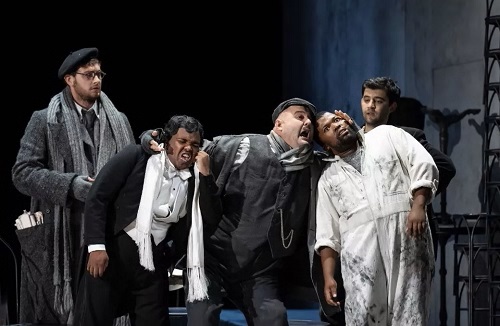
There is always a danger that in spelling out what we know, Visser will destroy the emotional trajectory of the opera. But, the director stays just the right side of overkill. He knows the value of a visual image. And, so, in the final bars, Death took Mimì by the hand and they walked together into the darkness. Rodolfo’s grief-stricken cries were heart-breaking.
The previous evening, the Canterbury audience enjoyed a revival of Michael Grandage’s Le nozze di Figaro, first seen in 2012 and revived here by Ian Rutherford. Christopher Oran’s designs, beautifully lit by Paule Constable, update the action but retain the locale: Moorish Seville sets meets Seventies modernity. Some of the questionable ‘translations’ in the surtitles are wince-making, but this production is a visual feast, whether it’s the elegance – all ochres, golds and oranges – of the Countess’s bedroom that one admires, or the magical nocturnal fragrance of the Act IV garden scene, or simply Figaro’s and the Count’s floppy hair and velvet flares. The disadvantage of the sumptuousness is that it takes a while to swivel the sets between Acts, and the performance I attended was 35 minutes longer than the stated running time. But, this is a genial, gracious production that tells its tale plain and true, albeit without the political ‘kick’ embedded within the comic capers.
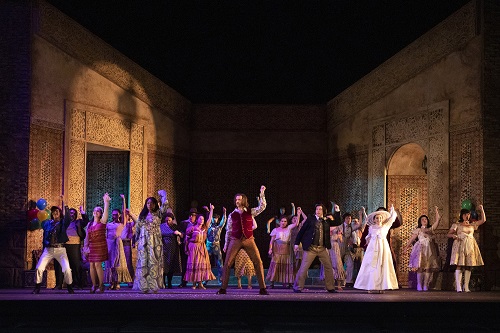
It seemed to take the cast a little while to become accustomed to the acoustics of the venue, but they grew into their roles. The Russian bass-baritone Alexander Miminoshvili was a personable Figaro, engaging and warm of voice and manner. Replacing the indisposed George Humphries, Patrick Keefe seemed a bit underpowered as the Count, but embodied the spirit of free love affably enough. Henry Waddington blustered ostentatiously as Bartolo, though he didn’t quite get through the patter of ‘La vendetta’ unscathed. Madeleine Shaw was a forthright Marcellina, and Colin Judson aptly oleaginous as Basilio. Charlotte Bowden, a Jerwood Young artist, sang Barbarina’s Act IV aria charmingly; it would have been good to have heard more from her.
The stage business feels a bit clichéd at times but sometimes being served the familiar makes for a comforting feast, especially when the libretto that has more than its fair share of narrative leaps of faith, equal to Cherubino’s plunge into the garden from Countess’s bedroom. The conductor Stephanie Childress keeps the show moving convincingly along, though there are some anomalies: why some tongued phrases for the woodwind in the overture, for example, when the score distinctly indicates slurs? And, there were some surprising tempi, not least the hasty rush for both of Cherubino’s numbers, which deprived Swedish mezzo soprano Ida Ränzlöv – whom it’s always a pleasure to hear, and who was all puppyish optimism and adolescent verve – of the opportunity to really ‘act’ ‘Non so più’ and ‘Voi che sapete’. Childress also seemed to be pushing ahead of her cast at times, and the itchy-fingered continuo – fortepiano (Matthew Fletcher) and cello (Jonathan Tunnell) – had my nerves jangling.
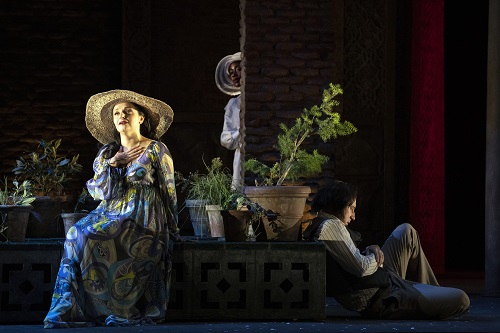
But, there were vocal consolations. Nardus Williams evinced a wonderful shine and maturity as the Countess. It’s quite early in her career, perhaps, for Williams to be venturing this role, but she sang with true elegance and composure. If ‘Porgi amor’ was a little tentative then ‘Dove sono’ bloomed wonderfully. The star of the evening, for me, was Soraya Mafi as Susanna: her performance was witty, pert, alert, vocally crystalline and precise, and utterly captivating. Mafi had to wait a long while for her own ‘big number’ but Act 4’s ‘Deh vieni’ was very much worth the wait. Both Williams and Mafi rose above Grandage’s comic innuendo and restored Mozart’s grace.
Glyndebourne Touring Opera’s autumn tour continues in Norwich and Liverpool until 26th November.
Claire Seymour
Mozart: Le nozze di Figaro
Figaro – Alexander Miminoshvili, Susanna – Soraya Mafi, Count Almaviva – Patrick Keefe, Countess – Nardus Williams, Cherubino – Ida Ränzlöv, Bartolo – Henry Waddington, Don Basilio – Colin Jackson, Marcellina – Madeleine Shaw, Antonio – Nicholas Folwell, Don Curzio – Stephen Mills, Barbarina – Charlotte Bowden; Director – Michael Grandage, Conductor – Stephanie Childress, Revival Director – Ian Rutherford, Designer – Christopher Oram, Lighting Designer – Paule Constable, Movement Director – Ben Wright, Revival Movement Director – Kieran Sheehan, The Glyndebourne Chorus and Tour Orchestra.
Puccini: La bohème
Mimì – Gabriella Reyes, Rodolfo – Bekhzod Davronov, Musetta – Mariam Battistelli, Marcello – Luthando Qave, Colline – William Thomas, Schaunard – Luvuyo Mbundu, Benoît/Alcindoro – Darren Jeffrey, Death/Parpignol – Peter Van Hulle, Customs Officer – Andrew Davies, Police Sergeant – John Mackenzie-Lavansch; Director – Floris Visser, Conductor – Rory Macdonald, Revival Director – Simon Iorio, Set Designer – Dieuweke Van Reij, Costume Designer – Jon Morrell, Lighting Designer – Alex Brok, Choreographer – Pim Veulings, The Glyndebourne Chorus and Tour Orchestra.
The Marlowe Theatre, Canterbury; Friday 11th and Saturday 12th November 2022.